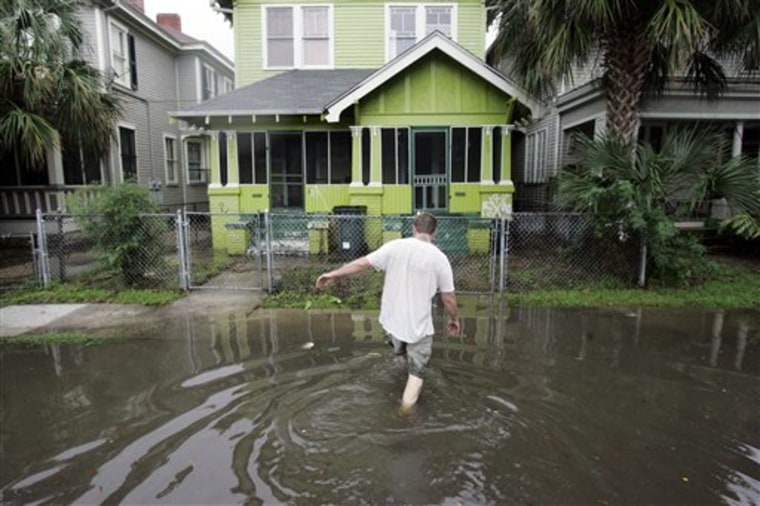With a shake of the head, Richie Stevens looked at the brownish, oil-streaked water surrounding his property Tuesday and wondered how so much of the city could be swamped by a rainfall not even associated with a hurricane.
"This was a little rain flood," Stevens said. "What happens if we get a big storm?"
On Monday, bands of heavy rain dumped about 7 inches of rain on New Orleans and its suburbs, leaving many streets impassable and flooding some businesses and homes. The city's system of pumps and drainage canals, while nearly back to its capacity before Hurricane Katrina hit on Aug. 29, 2005, couldn't keep up.
Mayor Ray Nagin shut City Hall early and schools were closed across the city. Waist-high water in parts of eastern New Orleans soaked businesses, some of which had only recently reopened after being damaged by Katrina. The Army Corps of Engineers had to close a floodgate on the Harvey Canal because of flooding fears.
By Tuesday, most of the city was dry but a few spots were still flooded. Officials declared the city's efforts to fight the flood a success.
No pump failures
"The system is solid," said Robert Jackson, a spokesman for the Sewerage and Water Board, the agency that runs the city's complex system of catch basins, massive pumps, drainage canals and drainage pipes.
There were no reports of pump failures and flooding was minor in most places. It was the biggest test the city has had since Katrina in 2005, which dumped 13 inches of rain on New Orleans.
Still, the scene at Stevens' place was a flashback to Katrina. People waded through knee-deep water. Military police directed traffic. Stagnant water lapped at the windows of a black limousine parked in front of Stevens' property, which is leased to automobile mechanics and a door retail outlet.
In a way, Katrina contributed to Monday's flood: debris from the ongoing recovery clogs catch basins and drainage lines.
Stevens was waiting for city and state officials to unclog a drainage pipe that apparently had caused water to stack up — a problem complicated by confusion over which agency had responsibility for the drainage line, an official said.
And the rate of Monday's rainfall also contributed to the flooding. When all the pumps are running, the system can drain 1 inch of rainfall in the first hour and a half inch every hour after that. Most of the rain fell within six hours.
Some drought relief
Across the Southeast, residents of drought-stricken areas welcomed the showers and thunderstorms that visited the region Monday. Drought in almost one-third of the region has been deemed "exceptional" — the most severe drought category.
The Atlanta area, with a population of 5 million, is smack in the middle of the affected region, which includes most of Tennessee, Alabama and the northern half of Georgia, as well as parts of North and South Carolina, Kentucky and Virginia.
Despite Monday's much-needed rainfall, Georgia Gov. Sonny Perdue ordered businesses and utilities in 61 northern Georgia counties to cut water usage by 10 percent on Tuesday. He called the move a "first step" in reducing water usage, and encouraged residents to treat drying lawns and dirty cars as a "badge of honor."
Thunderstorm warnings continued Tuesday in parts of Alabama, but the rainfall amounts were far below the levels needed for soils parched by drought. The National Weather Service reported much of central and northern Alabama — where the drought has been harshest — got less than an inch during the previous 24 hours.
The weather service said about 30 structures were damaged in Alabama's rural Hale County, about 100 miles southwest of Birmingham. Powerful winds also toppled power lines and uprooted trees in Dallas, Etowah, Bibb and Talladega counties.
In Kentucky, there was cause for optimism, with reports of 3 to 5 inches of rain common as Monday's showers continued into Tuesday, said Mike Callahan, a National Weather Service hydrologist.
"The rivers and streams are rising, but so far no problems, which shows how dry we were," Callahan said.
For those areas receiving the soaking rains, "this could very well be the start of the end of this drought," said Tom Priddy a University of Kentucky extension agricultural meteorologist.
"It's like liquid gold," he said.
